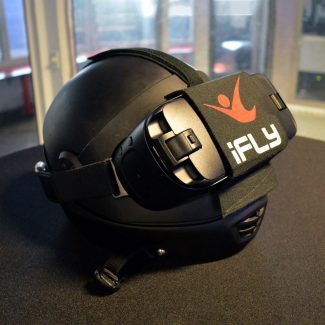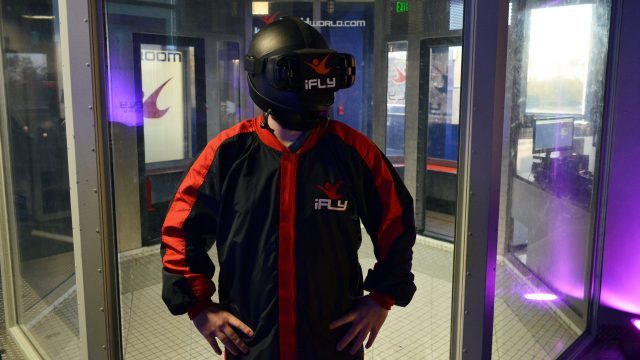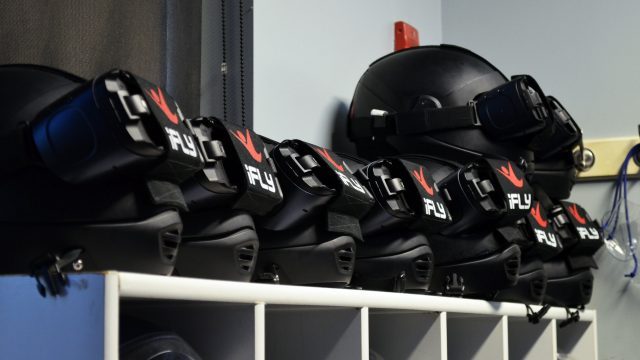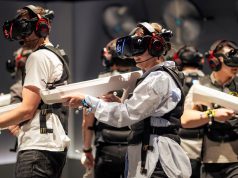iFLY, a leading provider of indoor skydiving facilities, today launched their iFLY VR initiative which combines the company’s indoor skydiving experience with immersive visuals powered by a Gear VR headset. I got to try to experience for myself at the company’s SF Bay location.
Now available at 28 locations in the US, the iFLY VR experience is an optional $20 add-on to the usual indoor flight experience offered by the company (which starts around $70). After training and getting a feel for stable non-VR flying, customers don a purpose-built helmet which incorporates a Gear VR headset. They can choose between several different skydiving locations—like Dubai, Hawaii, or Switzerland—where iFly has recorded real skydives specifically for use in the iFly VR experience.
I went to the company’s SF Bay location to try the iFly VR experience first hand, and came away feeling like I got to experience the ultimate haptic simulation.

First, the setup. Having never been skydiving before (indoor or out) I went through the usual iFly procedure: I watched a short training video, put on a jumpsuit and helmet, and stepped into the wind chamber for a minute or two with an instructor who guided me through achieving a basic stable flight posture. After a quick break, I went back in for another short session which was capped off with the instructor grabbing hold of me and sending us both spiraling up and down the chamber with surprising speed (and control). Having gotten a feel for a stable flying posture, it was time for VR.
I took off the usual helmet and goggles and put on iFly’s custom made VR skydiving helmet. Unlike the non-VR helmet, this one covered my eyes and mouth completely, which meant that my entire face was enclosed—a somewhat frightening prospect considering I was about to step into a room where usual physics don’t apply.

Thankfully the prior sessions with the skilled instructor instilled a feeling that he had deft control over my movements inside the chamber, and that I could trust him to keep me from flying into a wall.
With that trust in the back of my mind, I stepped up to the chamber door, only able to see a small slice of the world through the Gear VR’s rear camera. Once I was in position, with the instructor there ready to pull me into the chamber, he hit a button on the headset which switched the view to the pre-recorded 360 video.
The video starts with a view of other people jumping out of a plane in front of you, and someone gives you a countdown on their fingers which was my queue to lean out of the door and into the chamber. The instructor maneuvered me into position as I did my best to maintain the stable flying posture that I had learned earlier (though without the visual feedback of the chamber around me, I was really just winging it).
Inside the headset, the field of view was quite limited, like looking through binoculars, because Gear VR naturally has a lower field of view that some other headsets, and on top of that my eyes weren’t as close as they could have been to the lenses. The view was also showed more rumble than I would have liked (understandable, considering the phone’s IMU probably wasn’t built for such a use-case), but the footage was competently shot; as I ‘fell’, I could see the ground far below me and there were even other skydivers falling around me, motioning to me and showing off some tricks.
The instructor, who could see my view on an external monitor, kept me stable and also spun me around a bit to see more of the scene around me. Quickly after it began, I could feel the instructor shuffling me over to the door, and the pass-through view was restored so that I could manage to grab the door frame and pull myself out of the chamber.
The best part of the experience is definitely the ‘haptics’—although you aren’t really falling out of a plane, you feel all of the same forces that you would if you had. Two powerful fans are responsible for generating enough lift to counteract the force of gravity, and the feeling of all that wind rushing over you really makes the experience feel real; meanwhile the added VR visuals allow your brain to interpret the feeling in a new context—in the VR flight I felt a serious adrenaline rush that I didn’t get from the non-VR flights, likely because my body went from thinking it was floating in a static environment to plummeting through the sky.
– – — – –
After my session, I caught up with Mason Barrett, Director of Product Development at iFly, who was part of developing and deploying the iFly VR experience.
From my discussions with Barrett I came away feeling like iFly VR is by no means a gimmick. The company seems to have achieved a solid execution considering the available hardware, and has rapidly rolled out the experience to the vast majority of its locations after lots of preliminary testing (Barrett told me nearly 1,000 people tested the experience prior to the rollout), and adequate time for training the crucial instructors which really make it all possible.

Barrett told me that iFly VR isn’t an experiment, but a serious new venture for the company, and that they’ve got their eyes on future VR technology which could further enhance the experience. iFly also plans to expand their VR content offering going forward, offering more locations and even the possibility of CGI or real-time rendered experiences in the future.









